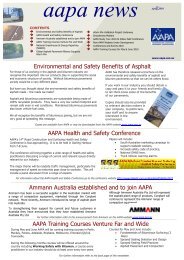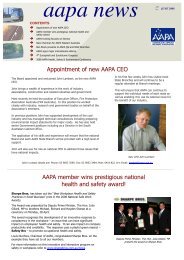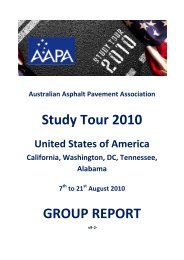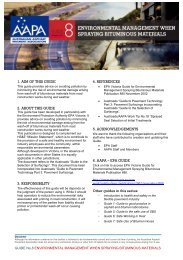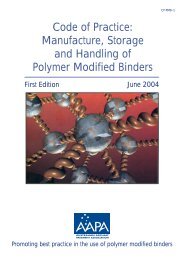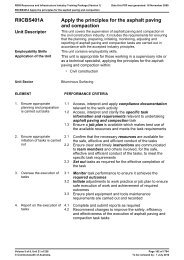Asphalt Review - Volume 29 Number 2 (June / July 2010)
Asphalt Review - Volume 29 Number 2 (June / July 2010)
Asphalt Review - Volume 29 Number 2 (June / July 2010)
Create successful ePaper yourself
Turn your PDF publications into a flip-book with our unique Google optimized e-Paper software.
BITUMEN<br />
STABILISATION IN<br />
SOUTH AFRICA<br />
To understand bitumen stabilisation technology (materials<br />
treated with bitumen emulsion or foamed bitumen), it is<br />
important to know the history of this technology.<br />
BSMs have been used in South Africa for more than 30 years.<br />
The concept of emulsion treatment came to the fore in the<br />
1970s when a newly constructed freeway suffered a catastrophic<br />
premature failure. The failed cemented base material was retreated<br />
with bitumen emulsion and most of those sections are<br />
still in a satisfactory condition today.<br />
The following paper, prepared by DC Collings, Loudon<br />
International, South Africa (davecol@iafrica.com), was also<br />
featured at AAPA’s 13th International Flexible Pavements<br />
Conference.<br />
Condensed version - full version available from Conference<br />
papers 2009 - aapa@asn,com.au<br />
The advent of foamed bitumen in South Africa<br />
During 1993, in pursuit of an alternative to bitumen emulsion,<br />
a Joint Venture (JV) between a large construction company,<br />
a small design firm and a foreign manufacturing company<br />
imported a specialised 400 t/hr foamed bitumen mixing plant<br />
from the foreign company. The mixing plant was duly established<br />
on site in April 1994. The anticipated construction period was<br />
four weeks.<br />
From the outset, everything that could have gone wrong did<br />
go wrong. On the odd occasion when foam was produced, the<br />
resulting bitumen stabilised material allowed the 150mm thick<br />
base layer to be successfully paved. A rudimentary method<br />
for operating the plant was eventually developed, allowing a<br />
satisfactory product to be mixed at an exceedingly slow rate.<br />
Despite this, the road is still in good condition 15 years later,<br />
in spite of the abusive loading it has received from timber<br />
haulage.<br />
Two major benefits did accrue from these expensive lessons:<br />
• foamed bitumen was shown to be a viable and highly<br />
attractive substitute for bitumen emulsion as a stabilising<br />
agent (the product was good, the equipment was flawed);<br />
and<br />
• an in-depth understanding of the problems encountered<br />
when using an expansion chamber to produce foamed<br />
bitumen.<br />
The new “properly engineered” system<br />
Following this project and a short but intensive research<br />
and development effort by the manufacturer’s engineering<br />
design team, the prototype spraybar for producing foamed<br />
bitumen was subjected to a series of trials in Germany in<br />
November 1995. The system was then mounted on a newgeneration<br />
recycler and shipped out to South Africa for<br />
field trials. Six weeks of continuous work followed before<br />
the Germans declared that the system was satisfactory. The<br />
system currently manufactured by this company, some 13<br />
years later, is exactly the same.<br />
Bitumen stabilisation in South Africa<br />
Within a year of completing these trials, four South African<br />
contractors had purchased large recycling machines equipped to<br />
apply foamed bitumen. These contractors quickly identified the<br />
economic advantages to be gained by substituting foamed bitumen<br />
for bitumen emulsion in tenders calling for the construction of<br />
an emulsion treated base (ETB). As a result, several contracts<br />
were awarded in favour of foamed bitumen, in spite of the Road<br />
Authority’s uncertainty as to whether or not foamed bitumen was<br />
indeed as effective as bitumen emulsion.<br />
Subsequent to developing the full-scale system for mounting on<br />
large recyclers, a small laboratory unit was developed to support<br />
the design aspect of this new technology.<br />
TG2 Second Edition and technology development<br />
Following the successful use of foamed bitumen the emulsion<br />
manufacturers supported the development of two documents<br />
through SABITA. However, these imposed a number of<br />
limitations. Subsequently a technical guidelines document<br />
TG2 was developed and released in 2002.<br />
Subsequently experience in South Africa and overseas<br />
highlighted deficiencies in TG2 and work was done to review<br />
those guidelines.<br />
This review took five years to complete with funding<br />
provided by SABITA and Gautrans and the new edition of<br />
TG2 was published in May 2009. It was titled TG 2 Second<br />
Edition, Bitumen Stabilised Materials, A Guideline for the<br />
Design and Construction of Bitumen Emulsion and Foamed<br />
Bitumen Stabilised Materials.<br />
TG2 Second Edition therefore replaces Sabita’s Manuals 14<br />
and 21 as well as the original TG2. Regardless of whether<br />
bitumen emulsion or foamed bitumen is applied as the<br />
stabilising agent, the same mix design and pavement design<br />
procedures are applicable to both and the new method for<br />
classifying BSMs takes no account of which stabilising agent<br />
was used in the mix.<br />
BSM CHARACTERISTICS AND<br />
PERFORMANCE<br />
BSMs are pavement materials that are treated with either<br />
bitumen emulsion or foamed bitumen. The materials treated<br />
are either those recovered from an existing pavement or fresh<br />
materials. Granular materials, previously cement treated<br />
materials or reclaimed asphalt (RA) layers are included.<br />
Where an existing pavement is recycled, old seals or asphalt<br />
surfacing is usually mixed with the underlying layer and<br />
treated to form a new base or sub-base layer.<br />
ROADS JUNE <strong>2010</strong>/JULY <strong>2010</strong> <strong>29</strong>



